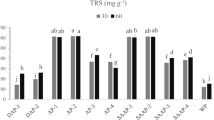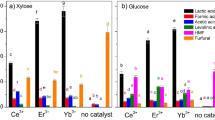Abstract
Acid hydrolysis is a simple and direct way to hydrolyze polysaccharides in biomass into fermentable sugars. To produce fermentable sugars effectively and economically for fuel ethanol, we have investigated the hydrolysis of Enteromorpha using acids that are typically used to hydrolyze biomass: H2SO4, HCl, H3PO4 and C4H4O4 (maleic acid). 5%(w/w) Enteromorpha biomass was treated for different times (30, 60, and 90 min) and with different acid concentrations (0.6, 1.0, 1.4, 1.8, and 2.2%, w/w) at 121°C. H2SO4 was the most effective acid in this experiment. We then analyzed the hydrolysis process in H2SO4 in detail using high performance liquid chromatography. At a sulfuric acid concentration of 1.8% and treatment time of 60 min, the yield of ethanol fermentable sugars (glucose and xylose) was high, (230.5 mg/g dry biomass, comprising 175.2 mg/g glucose and 55.3 mg/g xylose), with 48.6% of total reducing sugars being ethanol fermentable. Therefore, Enteromorpha could be a good candidate for production of fuel ethanol. In future work, the effects of temperature and biomass concentration on hydrolysis, and also the fermentation of the hydrolysates to ethanol fuel should be focused on.
Similar content being viewed by others
References
Chattopadhyay K, Mandal P, Lerouge P et al. 2007. Sulphated polysaccharides from Indian samples of Enteromorpha compressa (Ulvales, Chlorophyta): Isolation and structural features. Food Chem., 104: 928–935.
Fletcher R L. 1996. The occurrence of “green tides”: a review. In: Schramm W, Nienhuis P H eds. Marine Benthic Vegetation: Recent Changes and the Effects of Eutrophication. Springer, Berlin, Germany. p.7–43.
Hao G T, Chen S W, Zhu S et al. 2007. Analysis of monosaccharides and uronic acids in ploysaccharides by pre-column derivatization with p-aminobenzoic acid and high performance liquid chromatography. Chin. J. Chromatogr., 25(1): 75–79.
Horn S J, Aasen I M, Østgaard K. 2000. Ethanol production from seaweed extract. J. Ind. Microbiol. Biotechnol., 25: 249–254.
Knauf M, Moniruzzaman M. 2004. Lignocellulosic biomass processing: A perspective. Int. Sugar J., 106: 147–150.
Lin A P, Shen S D, Wang J W et al. 2008. Reproduction diversity of Enteromorpha prolifera. J. Integr. Plant Biol., 50(5): 622–629.
Lin Y, Tanaka S. 2006. Ethanol fermentation from biomass resources: Current state and prospects. J. Appl. Microbiol. Biotechnol., 69: 627–642.
Mielenz J R. 2001. Ethanol production from biomass technology and commercialization status. Curr. Opin. Microbiol., 4: 324–329.
Pérez-Lloréns J L, Brun F G, Andría J et al. 2004. Seasonal and tidal variability of environmental carbon related physico-chemical variables and inorganic C acquisition in Gracilariopsis longissima and Enteromorpha intestinalis from Los Toruños salt marsh (Cádiz Bay, Spain). J. Exp. Mar. Bio. Ecol., 304(2): 183–201.
Rajeev K, Sukumaran, Singhania R R et al. 2009. Cellulase production using biomass feed stock and its application in lignocellulose saccharification for bio-ethanol production. Renewable Energy, 34: 421–424.
Sun S, Wang F, Li C L et al. 2008. Emerging challenges: Massive green algae blooms in the Yellow Sea. Nature Precedings, hdl:10101/npre.2008.22661.1. http://precedings.nature.com/documents/2266/version/1/files/npre20082266-1.pdf.
Sun Y, Cheng J J. 2005. Dilute acid pretreatment of rye straw and bermudagrass for ethanol production. Bioresour. Technol., 96: 1 599–1 606.
Téllez-Luis S J, Ramírez J A, Vázquez M. 2002. Mathematical modelling of hemicellulosic sugar production from sorghum straw. J. Food Eng., 52: 285–291.
Zaldivar J, Nielsen J, Olsson L. 2001. Fuel ethanol production from lignocellulose: A challenge for metabolic engineering and process integration. Appl. Microbiol. Biotechnol., 56: 17–34.
Author information
Authors and Affiliations
Corresponding author
Additional information
Supported by the National High Technology Research and Development Program of China (863 Program) (No. 2009AA10Z106), the Major State Basic Research Development Program (No. 2011CB200902), the CAS International Innovation Partnership Program: Typical Environmental Process and Effects on Resources in Coastal Zone Area, the National Key Technology Research and Development Program (No. 2008BAC49B01), the National Natural Science Foundation of China (Nos. 40876082, 30870247), Outstanding Young Scholar Fellowship of Shandong Province (No. JQ200914), and the Science and Technology Project of Qingdao City (No. 09-1-3-59-jch).
Rights and permissions
About this article
Cite this article
Feng, D., Liu, H., Li, F. et al. Optimization of dilute acid hydrolysis of Enteromorpha . Chin. J. Ocean. Limnol. 29, 1243–1248 (2011). https://doi.org/10.1007/s00343-011-0298-x
Received:
Accepted:
Published:
Issue Date:
DOI: https://doi.org/10.1007/s00343-011-0298-x




